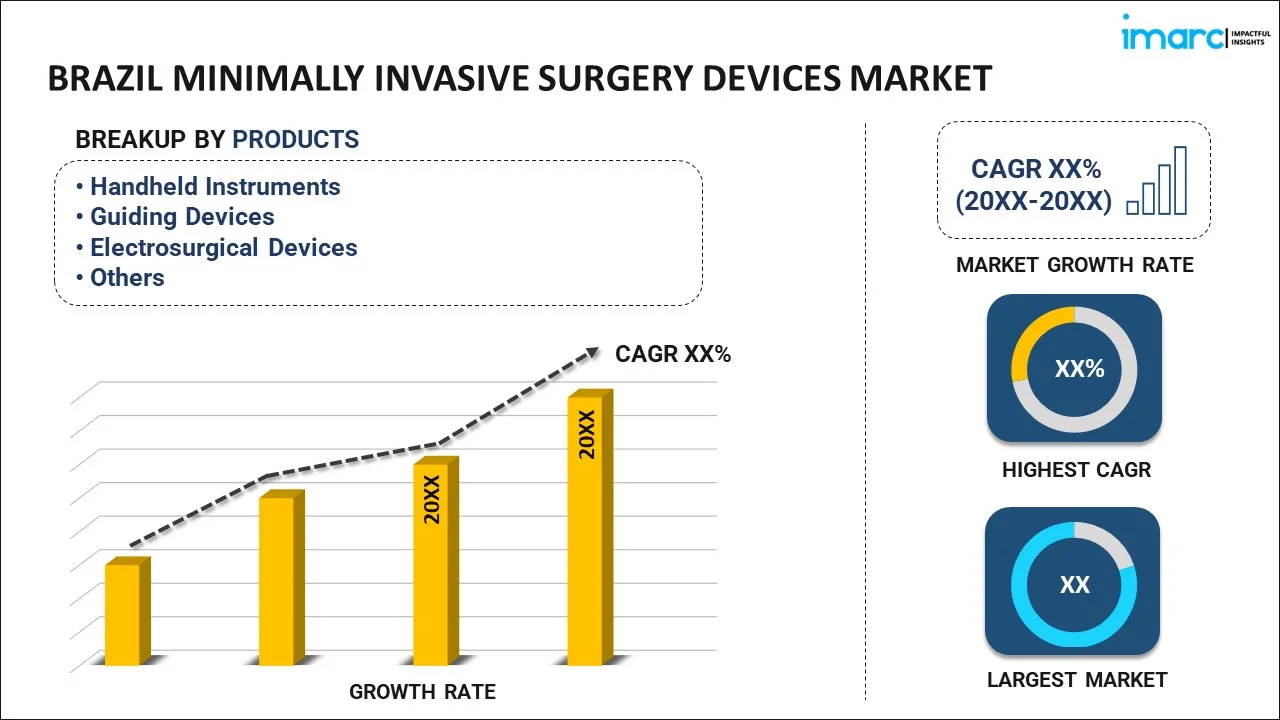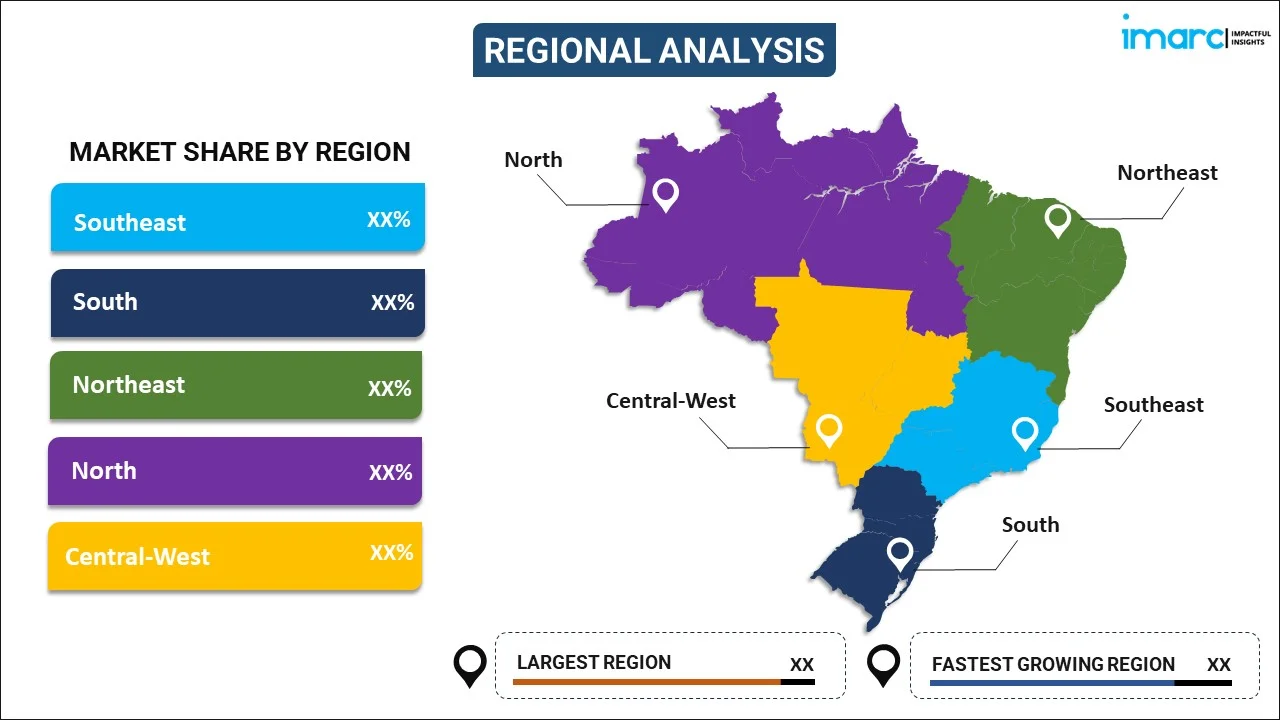
Brazil Minimally Invasive Surgery Devices Market Report by Product (Handheld Instruments, Guiding Devices, Electrosurgical Devices, Endoscopic and Laparoscopic Devices, Monitoring and Visualization Devices, Ablation and Laser Based Devices, and Others), Application (Aesthetic, Cardiovascular, Gastrointestinal, Gynecological, Orthopedic, Urological, and Others), and Region 2025-2033
Market Overview:
Brazil minimally invasive surgery devices market size reached USD 1,144 Million in 2024. Looking forward, IMARC Group expects the market to reach USD 2,364 Million by 2033, exhibiting a growth rate (CAGR) of 8.4% during 2025-2033. The rising incidence of neurological disorders, increased investment in healthcare infrastructure, and ongoing research and development (R&D) in the neurology field represent some of the key factors driving the market.
|
Report Attribute
|
Key Statistics
|
|---|---|
|
Base Year
|
2024 |
|
Forecast Years
|
2025-2033
|
|
Historical Years
|
2019-2024
|
| Market Size in 2024 | USD 1,144 Million |
| Market Forecast in 2033 | USD 2,364 Million |
| Market Growth Rate (2025-2033) | 8.4% |
Minimally invasive surgery (MIS) devices refer to a category of medical instruments and equipment specifically designed for performing surgical procedures with significantly reduced trauma to the patient's body compared to traditional open surgeries. These devices facilitate procedures that are less invasive, typically involving small incisions, and rely on advanced technologies like endoscopy and robotics. MIS devices encompass a wide range of tools, including laparoscopic instruments for abdominal surgeries, arthroscopic equipment for joint procedures, and robotic-assisted surgical systems. They often include miniature cameras and precision surgical instruments that enable surgeons to navigate and operate within the body's cavities with enhanced visualization, control, and precision. MIS offers numerous advantages, including reduced post-operative pain, shorter hospital stays, quicker recovery times, and minimized scarring, making it a preferred approach for patients and healthcare providers. The ongoing advancements in MIS technology and techniques continue to revolutionize the field of surgery, expanding its applications and improving patient outcomes in diverse medical specialties.
Brazil Minimally Invasive Surgery Devices Market Trends:
The rising geriatric population in Brazil is primarily driving the Brazil MIS devices market, as older individuals are more prone to a wide range of medical conditions that can be effectively treated through MI procedures. Besides this, the evolving healthcare infrastructure and the expansion of private healthcare facilities have improved access to advanced surgical techniques, including MIS, subsequently boosting the demand for corresponding devices. Moreover, the economic development and rising income levels in Brazil have contributed to the growing adoption of private health insurance, enabling more individuals to access MIS procedures, thereby strengthening the market growth. In confluence with this, significant advancements in medical technology, including improved endoscopic cameras, robotic surgical systems, and precision instruments, have made MIS procedures more efficient, precise, and accessible, thus fueling the demand for MIS devices. Concurrently, the rising prevalence of lifestyle-related diseases, such as obesity and diabetes has led to a greater need for MI weight loss and metabolic surgeries, which has spurred the demand for specialized MIS devices in the Brazilian market. In addition to this, the global COVID-19 pandemic has further increased the adoption of minimally invasive techniques as they reduce the risk of virus transmission, decrease hospitalization times, and offer quicker recovery for patients, impelling the need for MIS devices in the healthcare sector. Furthermore, various government investments in healthcare, such as the establishment of minimally invasive surgery centers and the acquisition of state-of-the-art equipment, driven by the need to enhance healthcare accessibility and quality, have propelled the demand for MIS, thereby aiding in market expansion.
Brazil Minimally Invasive Surgery Devices Market Segmentation:
IMARC Group provides an analysis of the key trends in each segment of the market, along with forecasts at the country level for 2025-2033. Our report has categorized the market based on product and application.
Product Insights:

- Handheld Instruments
- Guiding Devices
- Electrosurgical Devices
- Endoscopic and Laparoscopic Devices
- Monitoring and Visualization Devices
- Ablation and Laser Based Devices
- Others
The report has provided a detailed breakup and analysis of the market based on the product. This includes handheld instruments, guiding devices, electrosurgical devices, endoscopic and laparoscopic devices, monitoring and visualization devices, ablation and laser based devices, and others.
Application Insights:
- Aesthetic
- Cardiovascular
- Gastrointestinal
- Gynecological
- Orthopedic
- Urological
- Others
A detailed breakup and analysis of the market based on the application have also been provided in the report. This includes aesthetic, cardiovascular, gastrointestinal, gynecological, orthopedic, urological, and others.
Regional Insights:

- Southeast
- South
- Northeast
- North
- Central-West
The report has also provided a comprehensive analysis of all the major regional markets, which include Southeast, South, Northeast, North, and Central-West.
Competitive Landscape:
The market research report has also provided a comprehensive analysis of the competitive landscape in the market. Competitive analysis such as market structure, key player positioning, top winning strategies, competitive dashboard, and company evaluation quadrant has been covered in the report. Also, detailed profiles of all major companies have been provided.
Brazil Minimally Invasive Surgery Devices Market Report Coverage:
| Report Features | Details |
|---|---|
| Base Year of the Analysis | 2024 |
| Historical Period | 2019-2024 |
| Forecast Period | 2025-2033 |
| Units | Million USD |
| Scope of the Report | Exploration of Historical Trends and Market Outlook, Industry Catalysts and Challenges, Segment-Wise Historical and Future Market Assessment:
|
| Products Covered | Handheld Instruments, Guiding Devices, Electrosurgical Devices, Endoscopic and Laparoscopic Devices, Monitoring and Visualization Devices, Ablation and Laser Based Devices, Others |
| Applications Covered | Aesthetic, Cardiovascular, Gastrointestinal, Gynecological, Orthopedic, Urological, Others |
| Regions Covered | Southeast, South, Northeast, North, Central-West |
| Customization Scope | 10% Free Customization |
| Post-Sale Analyst Support | 10-12 Weeks |
| Delivery Format | PDF and Excel through Email (We can also provide the editable version of the report in PPT/Word format on special request) |
Key Questions Answered in This Report:
- How has the Brazil minimally invasive surgery devices market performed so far and how will it perform in the coming years?
- What has been the impact of COVID-19 on the Brazil minimally invasive surgery devices market?
- What is the breakup of the Brazil minimally invasive surgery devices market on the basis of product?
- What is the breakup of the Brazil minimally invasive surgery devices market on the basis of application?
- What are the various stages in the value chain of the Brazil minimally invasive surgery devices market?
- What are the key driving factors and challenges in the Brazil minimally invasive surgery devices?
- What is the structure of the Brazil minimally invasive surgery devices market and who are the key players?
- What is the degree of competition in the Brazil minimally invasive surgery devices market?
Key Benefits for Stakeholders:
- IMARC’s industry report offers a comprehensive quantitative analysis of various market segments, historical and current market trends, market forecasts, and dynamics of the Brazil minimally invasive surgery devices market from 2019-2033.
- The research report provides the latest information on the market drivers, challenges, and opportunities in the Brazil minimally invasive surgery devices market.
- Porter's five forces analysis assist stakeholders in assessing the impact of new entrants, competitive rivalry, supplier power, buyer power, and the threat of substitution. It helps stakeholders to analyze the level of competition within the Brazil minimally invasive surgery devices industry and its attractiveness.
- Competitive landscape allows stakeholders to understand their competitive environment and provides an insight into the current positions of key players in the market.
Need more help?
- Speak to our experienced analysts for insights on the current market scenarios.
- Include additional segments and countries to customize the report as per your requirement.
- Gain an unparalleled competitive advantage in your domain by understanding how to utilize the report and positively impacting your operations and revenue.
- For further assistance, please connect with our analysts.
 Inquire Before Buying
Inquire Before Buying
 Speak to an Analyst
Speak to an Analyst
 Request Brochure
Request Brochure
 Request Customization
Request Customization




.webp)




.webp)












